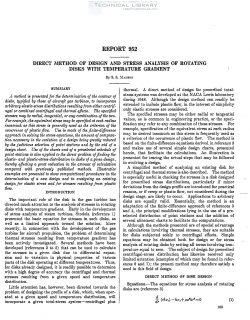naca-report-952

- Version
- 158 Downloads
- 1.17 MB File Size
- 1 File Count
- September 1, 2016 Create Date
- September 1, 2016 Last Updated
National Advisory Committee for Aeronautics, Report - Direct Method of Design and Stress Analysis of Rotating Disks with Temperature Gradient

The method is presented for the determination of the contour of
disks, typified by those of aircraft gas turbines, to incorporate
arbitrary elastic—stress distributions resultingfrom either centrif-
ugal or combined centrifugal and thermal effects. The specified
stresses may be radial, tangential, or any combination of the two.
For example, the equivalent stress may be specified at each radius
inasmuch as this stress is generally used as the criterion of the
occurrence of plastic flow. Use is made of the finite—difi'erence
approach in solving the stress equations, the amount of computa-
tion necessary in the evolution of a design being greatly reduced
by the judicious selection of point stations and by the aid of a
design chart. Use of the charts and of a preselected schedule of
point stations is also applied to the direct problem offinding the
elastic- and plastic-stress distribution in disks of a git-en design,
thereby ejecting a great reduction in the amount of calculation
compared with previously published methods. Illustratire
examples are presented to show computational procedures in the
determination of a new design and in analyzing an existing
design for elastic stress and for stresses resulting from plastic
flow.
The important role of the disk in the gas turbine has
directed much attention to the analysis of stresses in rotating
disks with temperature gradient. Early in the development
of stress analysis of steam turbines, Stodola (reference 1)
presented the basic equation for stresses in such disks, as
well as a limited approach toward the solution. More
recently, in connection with the development of the gas
turbine for aircraft propulsion, the problem of determining
thermal stresses resulting from temperature gradient has
been actively investigated. Several methods have been
developed (references 2 to 5) that can be used to calculate
the stresses in a given disk due to differential expan-
sion and to variation in physical properties of various
parts of the disk operating at different temperatures. Thus,
for disks already designed, it. is readily possible to determine
with a high degree of accuracy the centrifugal and thermal
stresses resulting from a given speed and temperature
distribution.
| File | Action |
|---|---|
| naca-report-952 Direct Method of Design and Stress Analysis of Rotating Disks with Temperature Gradient.pdf | Download |

Comment On This Post